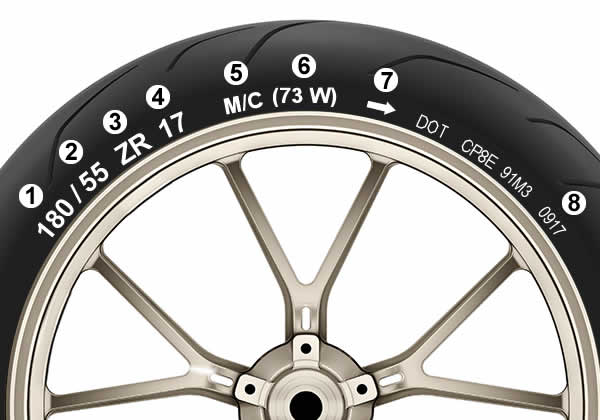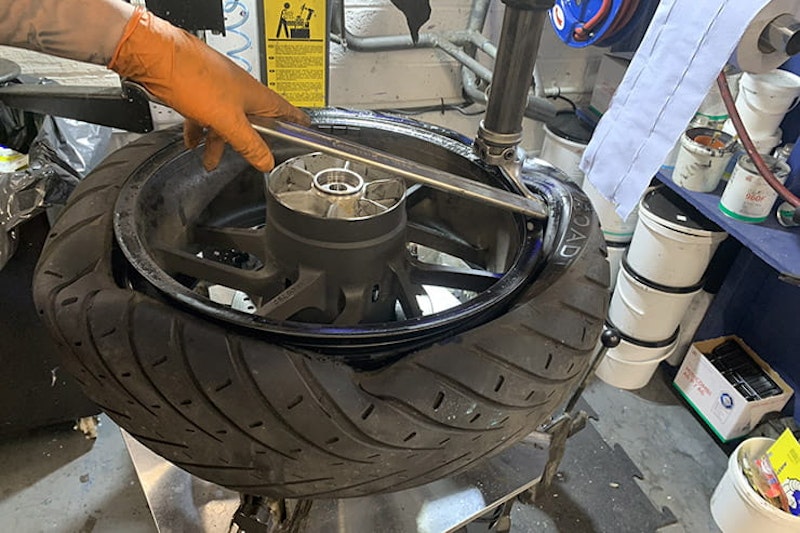All Regarding the Necessary Bike Tire Overview for Optimum Bike Maintenance and Efficiency
The Essential Motorbike Tyre Overview acts as a crucial resource for cyclists looking for to improve their bike's efficiency and safety. motorcycle tyre guide. It gives insights into different tyre kinds and specs that affect taking care of and durability. In addition, understanding appropriate upkeep methods can substantially extend tyre life. Nonetheless, several cyclists ignore critical aspects that impact their riding experience. Checking out these aspects can result in notified choices that inevitably improve both security and pleasure when driving
Comprehending Motorbike Tire Types
When choosing motorcycle tires, understanding the different types readily available is essential for peak performance and safety and security. Motorcyclists run into different tyre groups, each developed for specific riding conditions and designs. Sport tyres highlight grip and responsiveness, making them ideal for high-performance bikes and track usage. Exploring tyres, on the other hand, emphasis on durability and convenience, ideal for long-distance rides. Off-road tyres feature hostile walk patterns, supplying traction on unequal surfaces, while dual-sport tyres supply flexibility for cyclists that change in between on-road and off-road conditions.Additionally, cruiser tyres are created for stability and a smooth adventure, providing to the one-of-a-kind demands of cruisers and touring bikes. Understanding these categories allows riders to pick tyres that align with their riding practices and ecological problems, ultimately improving both security and performance. Each kind plays a crucial role in ensuring a premium riding experience tailored to the individual motorcyclist's requirements.
Trick Tyre Specs Explained
Selecting the suitable motorcycle tyres includes more than simply comprehending the numerous types; it additionally requires knowledge with essential specifications that influence efficiency and security. Key requirements include tyre size, which is commonly shared as a collection of numbers showing size, element proportion, and rim diameter. This code is crucial for ensuring compatibility with the motorcycle.Another essential requirements is the lots index, indicating the optimum weight a tyre can support. The rate score denotes the maximum rate a tyre can safely take care of, vital for performance enthusiasts.Additionally, tread pattern and rubber compound affect grip, stability, and wear characteristics. Tyres with a softer compound have a tendency to give far better hold but wear faster, while more difficult compounds last longer however may sacrifice traction. Comprehending these specifications allows bikers to make enlightened decisions, enhancing both their safety and security and riding experience.
How to Pick the Right Tyres for Your Bike
Exactly how can a biker guarantee they choose the right tyres for their bike? Picking the suitable tires entails comprehending the particular needs based on riding design, climate, and terrain conditions. Cyclists need to first consult the bike's handbook to identify suggested tyre dimensions and specifications.Next, they should review the kind of riding they plan to do-- whether it's travelling, touring, or off-road. Each group has distinct tire designs tailored for peak performance.Additionally, riders should evaluate step patterns; deeper treads supply better hold in damp problems, while shallower footsteps improve stability on completely dry surfaces.Lastly, it is vital to examine the tyre's building and construction and material, as these aspects affect longevity and handling (motorcycle tyre guide). By assessing these aspects thoroughly, a biker can confidently select tires that enhance security, performance, and general riding experience
The Value of Tire Stress and Maintenance
Tyre stress is a substantial aspect of motorcycle maintenance that straight influences safety and security and performance. Keeping the correct tyre stress warranties excellent contact with the roadway, boosting grip and security during experiences. Under-inflated tires can lead to boosted rolling resistance, resulting in bad gas effectiveness and unnecessary wear on the tyres. Conversely, over-inflated tires may trigger a rough experience and minimize grip, specifically in wet conditions.Regularly checking tire pressure, ideally before each experience, is crucial to maintaining the motorcycle's general efficiency. Cyclists need to describe the manufacturer's specifications for the advised stress levels. In addition, keeping track of tyre problem and adjusting pressure according to tons and riding problems is important for security. Appropriate tyre upkeep contributes to expanded tire life expectancy, much better handling, and enhanced stopping performance. Inevitably, regular attention to tyre pressure and maintenance is vital for ensuring a pleasurable and safe riding experience.

Acknowledging Indications of Tyre Put On and Damages
Acknowledging signs of tyre wear and damage is vital for keeping bike safety and efficiency. Secret indicators include reviewing step deepness and performing a complete visual evaluation for any visible damage. Resolving these elements promptly can avoid further difficulties when traveling.
Tread Deepness Analysis
As cyclists take to the roadways, have a peek at this site the relevance of evaluating walk depth can not be overemphasized, since used or damaged tires can significantly impact security and efficiency. Walk deepness directly affects grip, braking distance, and cornering security. To evaluate tread deepness, cyclists must utilize a step deepness scale, determining the grooves at various factors throughout the tyre. A deepness of 2mm or less suggests substantial wear and requires prompt replacement. Furthermore, cyclists can use the "cent examination" by inserting a coin right into the step; if the top of Lincoln's head shows up, the tire is too used. Regular checks assure peak grip on diverse road conditions, promoting a more secure riding experience while improving the total handling of the motorcycle.
Aesthetic Damages Evaluation
Inspecting motorbike tyres for aesthetic damage is necessary for maintaining security when driving. Cyclists should consistently take a look at tires for signs of wear such as fractures, protrudes, or slits. Unequal wear patterns may suggest positioning concerns or inappropriate rising cost of living, leading to jeopardized performance. Furthermore, looking for international things embedded in the walk can avoid prospective blowouts. Riders need to pay very close attention to the sidewalls, as any cuts or abrasions can weaken the tyre's structure. Guaranteeing that the walk is without excessive wear is essential for perfect hold. Normal visual evaluations not only improve safety and security yet likewise extend the life of the tires, guaranteeing a smoother and more reliable riding experience. Prompt detection of damage can avoid costly repairs and crashes.
Seasonal Tyre Factors To Consider for Different Riding Conditions
When considering motorbike tires, seasonal problems play an essential role in efficiency. In damp weather condition, tyres created for boosted hold and water displacement come to be necessary for security. Additionally, winter months riding needs specific tyre features to ensure peak grip on chilly, possibly icy surface areas.

Damp Weather Performance
Damp climate conditions present distinct challenges for motorcyclists, making the choice of tires crucial for security and performance. Tires made for damp weather condition typically include much deeper treads and specialized rubber substances that enhance grasp on slippery surface areas. These tyres are engineered to carry water away, minimizing the danger of aquaplaning and boosting stability throughout rainfall. Cyclists should consider tires with a balanced layout, providing both traction and sturdiness in damp conditions. In addition, preserving correct tyre pressure is important, as under-inflated tires can compromise efficiency. When encountered with rain-soaked roadways, routine assessments for wear and damages are necessary to assure peak feature. Picking ideal wet-weather tyres inevitably adds to a more secure and more satisfying riding experience.
Winter Season Tyre Requirements
Riding in winter season problems presents distinct obstacles that demand specific tire requirements to ensure safety and performance. Wintertime motorbike tyres are created with deeper footsteps and softer rubber compounds, offering enhanced grip on cold and slippery surface areas. This is vital for maintaining traction on ice, snow, and damp roads. Furthermore, winter tyres often feature an one-of-a-kind walk pattern that assists network water away, minimizing the risk of aquaplaning. Motorcyclists ought to additionally take into consideration the tire's temperature level strength, as performance can decrease in extreme cold. It is essential to frequently inspect tire pressure, as it can drop substantially in lower temperature levels. By choosing the appropriate winter season tires, bikers can browse extreme problems with higher confidence and security, guaranteeing a safer riding experience.
Tips for Proper Tire Storage and Long Life
Proper tyre storage space is crucial for preserving their longevity and efficiency in time, as overlooking this facet can bring about premature damage. To assure optimal storage, it is important to maintain tyres in a trendy, dry environment far from straight sunlight and resources of warm, such as radiators or furnaces. Extreme warm can trigger rubber compounds to damage down, endangering the tire's integrity.Additionally, tyres need to be kept upright or piled horizontally, depending on their kind. It is advisable to turn them regularly to my review here protect against level places if stacked. Appropriate inflation is likewise crucial; tyres ought to be inflated to the maker's advised stress to prevent deformation.Lastly, it is useful to cover tyres with a safety product to secure them from dirt and pollutants. Adhering to these tips will assist extend the life of motorbike tyres, ensuring they stay reliable and risk-free for use when the riding season returns to.
Often Asked Concerns
How Typically Should I Change My Motorcycle Tyres?

Can I Mix Different Tire Brands on My Bike?
Mixing different tire brand names on a bike is generally not recommended. Variations in walk patterns, rubber compounds, and performance characteristics can lead to uncertain handling and compromised safety and security, potentially increasing the risk of accidents.
What Is the Life-span of a Bike Tyre?
The lifespan of a motorbike tyre normally ranges from 5,000 to 15,000 miles, influenced by factors such as riding design, tyre, and surface maintenance. Normal evaluations can help ensure peak efficiency and safety and security throughout their usage.
Exactly how Do I Deal With Old Motorcycle Tyres?
When taking care of old bike tyres, they ought to be taken to assigned recycling facilities. Lots of neighborhood waste monitoring solutions likewise offer tyre disposal programs, making certain eco-friendly handling and compliance with neighborhood regulations relating to tire waste.
Exist Any Type Of Tyre Service Warranties Offered for Motorcycles?
Lots of motorcycle tyre makers use guarantees that cover flaws in material and craftsmanship. The specifics vary by brand name and version, so it's crucial for bikers to evaluate individual service warranty terms prior to buying new tyres. Off-road tyres feature hostile walk patterns, giving traction on irregular surfaces, while dual-sport tires provide adaptability for cyclists who move in between off-road and on-road conditions.Additionally, cruiser tyres are made for stability and a smooth adventure, providing to the unique requirements of cruisers and touring bikes. Each classification has distinctive tyre designs customized for optimal performance.Additionally, cyclists should assess walk patterns; deeper treads supply far better grip in wet problems, while shallower footsteps enhance security on completely dry surfaces.Lastly, it is necessary to analyze the tyre's construction and product, as these variables affect longevity and handling. Proper tire maintenance contributes to extended tyre life expectancy, far better handling, and improved stopping efficiency. Appropriate rising cost of living is likewise vital; tires need to be blown up to the producer's advised pressure to prevent deformation.Lastly, it is valuable to cover tires with a safety product to secure them from dirt and impurities. The life-span of a bike tyre generally varies from 5,000 to 15,000 miles, influenced by aspects such as riding tyre, surface, and style upkeep.